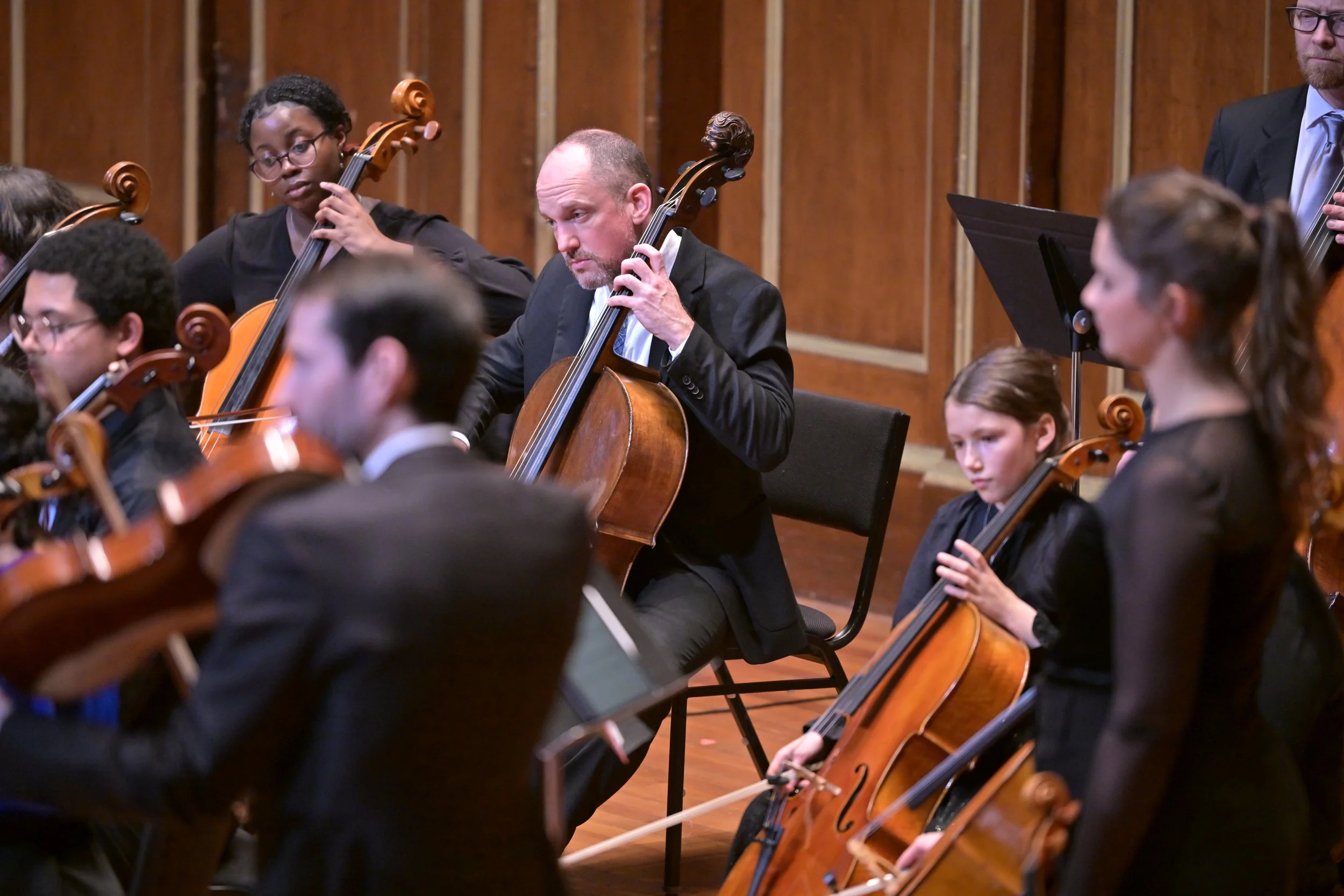DAVID DIAMOND (1915-2005)
ROUNDS FOR STRING ORCHESTRA
In 1944 America was in the grips of World War II. Dimitri Mitropolous, the renowned conductor, wrote to David Diamond, “These are distressing times. Most of the difficult music I play is distressing. Make me happy.” Diamond’s response was Rounds.
Diamond was born in Rochester, New York, and went on to study at the Cleveland Institute of Music, the Eastman School of Music, and in Paris with the legendary Nadia Boulanger. He, in turn would teach as a member of the composition faculty of the Juilliard School. For a time, his music was performed frequently, championed by Leonard Bernstein, amongst others, including Virgil Thomson who wrote in The New York Herald Tribune, “Composers, like pearls, are of three chief sorts, real, artificial and cultured. David Diamond is unquestionably of the first sort; his talent and his sincerity have never been doubted by his hearers, his critics, or by his composer colleagues.”
The title is re effective of the style, a round where the violins open and the low strings echo in return, and the music accomplishes its charge with aplomb: it is unabashedly exuberant throughout. Rounds became Diamond’s most well known work, and for good reason: we could all use a little happiness from time to time.
AARON COPLAND (1900-1990)
CLARINET CONCERTO
Benjamin, “Benny,” Goodman was born into poverty in a working class immigrant neighborhood of Chicago about which Jane Addams lamented, “The streets are inexpressibly dirty, the number of schools inadequate, sanitary legislation unenforced, the street lighting bad, the paving miserable and altogether lacking in the alleys and smaller streets...Hundreds of houses are unconnected with the street sewer.” Nonetheless, his father prioritized music, and enrolled Benny in clarinet lessons affordably offered at their local synagogue. The rest, as they say, is history. After becoming the “King of Swing,” in the jazz world, and taking that art form to its first concert outing in Carnegie Hall, he decided to return to his classical training. In April of 1938 he released a recording of the Mozart Clarinet Quintet in A major with the Budapest Quartet and embarked on taking formal lessons again at the age of forty—a true testament to his thirst for learning and expansion of musical vocabulary. He also began commissioning classical composers for music to perform: Béla Bartók, Malcolm Arnold, Morton Gould, Francis Poulenc, and Aaron Copland.
It was 1947 when Goodman approached Copland, who had been awarded the Pulitzer Prize for Appalachian Spring just two years prior, to write a clarinet concerto for him. A year later it was delivered to Goodman, who was uncertain about his ability to pull off the difficult technical passages of the work. Copland made some changes, but it still took until 1950 for Goodman to perform it—and even then, he did it on radio with the NBC Symphony Orchestra under the baton of Fritz Reiner. The public premiere took place a few weeks later with clarinetist Ralph McClane and the Philadelphia Orchestra led by Eugene Ormandy.
WILLIAM GRANT STILL (1895-1978)
MOTHER AND CHILD
During his tenure at the National Conservatory of Music in New York City, Dvorák’s students included a large number of talented African American musicians and composers whom he encouraged unreservedly, believing that they were the heart of the “American” sound. One of them, Maurice Arnold Strothotte gained Dvorák’s utmost respect as “the most promising and gifted” of his pupils. Other students included Will Marion Cook and Henry Thacker Burleigh. These young composers all blended the sounds of spirituals and plantation songs with the great European classical traditions, and while they experienced certain levels of success for the art they produced, they also met with resistance.
William Grant Still was born in Woodville Mississippi in 1895— the year Dvorák departed from New York to return to Europe. An early tragedy robbed him of his father when he was only three months old, but when his mother re-married, it was to a good man who treated Still like his own son, taking him to performances, purchasing records, and generally encouraging his musical interests. He would go on to enroll at the Oberlin Conservatory of Music after receiving a Bachelor of Science degree at Wilberforce University (pacifying his mother’s wishes for medical school), and eventually studied composition with George Whitfield Chadwick (who, incidentally, would be appointed Director of the New England Conservatory in 1897), and Edgard Varèse.
After collaborating with some of the biggest stars of the blossoming jazz scene in New York City, including Fletcher Henderson’s band, Still commenced on a set of “firsts”: the first African American to conduct the Los Angeles Philharmonic, the first African American to have his opera performed by the New York City Opera, the first African American to conduct the New Orleans Philharmonic Orchestra. His sizeable musical output includes five symphonies, eight operas, and musical arrangements for films including Pennies from Heaven (starring Bing Crosby), and The Lost Horizon.
Mother and Child was originally a movement from Still’s Suite for Violin and Piano, composed for the husband and wife violin and piano duo of Louis and Annette Kaufman. All three movements of the suite were inspired by the visual arts of African American sculptors and painters. Mother and Child drew from the work of Sargent Claude Johnson (1888-1967). It was premiered in Jordan Hall on March 14, 1944.
ANTONÍN DVORÁK (1841-1904)
STRING QUARTET IN F MAJOR OP. 96 (“AMERICAN”)
Dvorák’s time in the United States from 1892 to 1895 was musically fruitful, with a new symphony, string quartet, string quintet, and cello concerto added to his oeuvre, but not always easy or pleasant. He adapted, but was never at ease in the urban hustle and bustle of New York City. Furthermore, it was a financially troubled visit. After renewing his contract as Artistic Director and Professor of Composition at the National Conservatory of Music, his sponsor, Jeannette Thurber (president of the Conservatory) found she was unable to pay his salary due to economic difficulties. There was, however, one “ideal spot” (the composer’s description) during his tenure Stateside: a small town in Iowa with a large Czech community called Spillville, where he spent one summer. It was there that he wrote one of the chamber pieces that would become a favorite of many: the String Quartet in F major op. 96 (“American”). Inspiration came quickly for Dvorák, having completed the full sketch of the quartet in only three days, and completing it in two weeks.
The subtitle “American” that became attached to the quartet has something of a double meaning; it not only identifies the land of its conception, but also an assignment. Dvorák had been invited to the National Conservatory for a specific reason: to decipher the answer to the question, “What is ‘American’ Music?” After all, the bedrock of concert music was Europe, and to be considered “serious,” a young artist had to spend time studying abroad with the great masters, absorbing the great tradition. Mrs. Thurber, seeing Dvorák as a composer who successfully fused his native Czech sonorities with the broader European concert music tradition, concluded he would be ideal for explaining how one finds a “national” sound profile, and how one could teach that method in the conservatory classrooms of the United States (not only forming a musical “identity,” but keeping talent at home, so to speak).
The following scenario documents that when Dvorák arrived, searching for “possible basic material for a characteristic style,” he “asked Henry Thacker Burleigh, a black student at the National Conservatory, to sing him spirituals and plantation songs from the South and he asked the music critic Henry Krehbiel for transcriptions of Amerindian melodies...In many newspaper articles and interviews he expressed his belief that a national American style could be based on such traditional elements, among which he included pentatonism in the melodic line, a flattened leading note, plagal cadences, drone accompaniment, rhythmic ostinato and strongly syncopated rhythms.”
People groups tend to maintain their culture through food and music, wherever they are, under almost any circumstances. For Dvorák, infusing his music with Czech idioms was partially a political statement of maintaining and encouraging Czech culture as the people struggled for independence from Empire (for that reason, his music was sometimes avoided and not performed in Vienna). It may strike the reader that what Dvorák sought out in America was the music of individuals who had suffered forced displacement and slavery. Additionally, what he describes are the building blocks of what we think of as America’s great art form: jazz, a style of music that was born out of African musical traditions grafted into a new world. Jazz, that relies on the strength of the individual expressing the fullness of self, supported by group toward a larger goal, each, in time, taking a turn to speak and sing and add to the art of musical conversation.
It’s not the elements of music alone that can have any nationalistic fervor, but that those elements are found in the folk music of the inhabitants of the land, and are imbued with deep sentiments, memory, and love of place. It is that feeling that makes the music of a people. Is there anything more American than a Czech man campaigning for his own freedoms coming to a country across the ocean to meet with people from various walks of life—including the grandson of a freed slave and son of a German immigrant?
Program Notes by Kathryn J Allwine Bacasmot. Kathryn is a pianist/harpsichordist, musicologist, music & cultural critic, and freelance writer. She is a graduate of New England Conservatory, and writes program annotations for ensembles nationwide.
Photo By Dschwen - Own work, CC BY 2.5, https://commons.wikimedia.org/w/index.php?curid=494305


